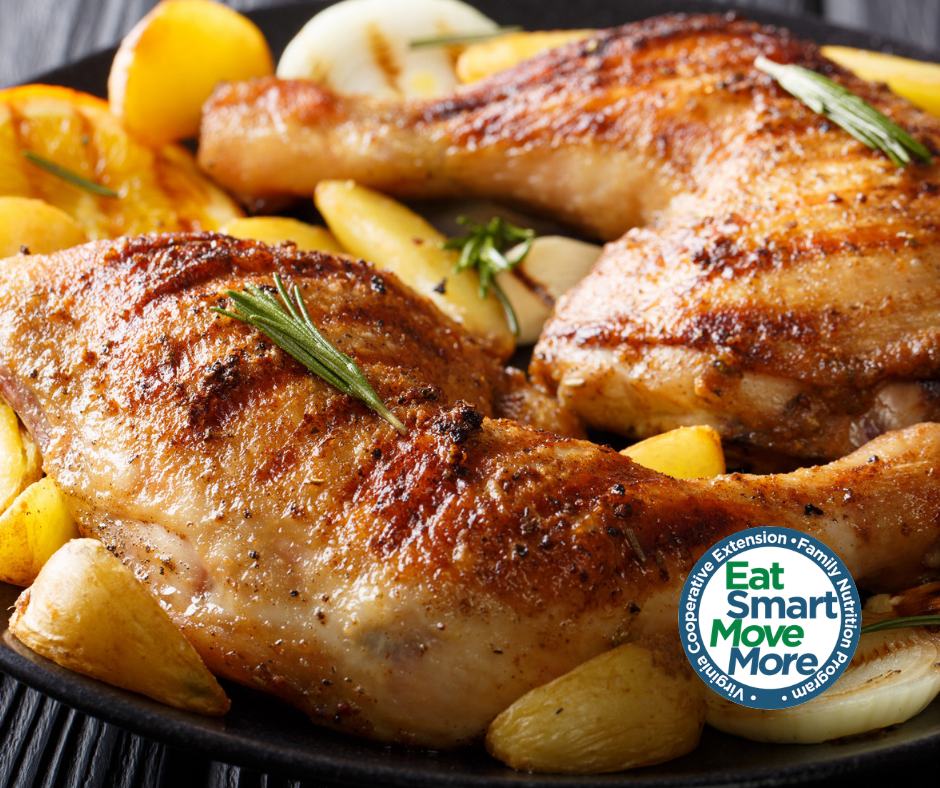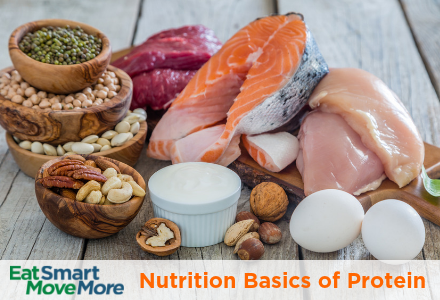In our previous post about the 6 Basic Nutrients, we gave a short description of the macronutrient protein. Today, we’ll go into more detail about protein, its functions in the body, sources of protein, and some information about different diets that focus on protein intake.
Protein Recommendations
The Dietary Guidelines for Americans protein recommendations are based on age and body weight because our bodies protein needs change over time as we grow and develop.
- Adults should eat at least .37 grams of protein per pound of body weight or 10-35% of calories from protein. This is about 55 grams of protein (minimum, based on body weight) or 50-175 grams (based on % of calories) for a 150 pound person eating a standard 2,000 calorie diet.
- For children, the recommended amount of protein is between .39-.69 grams per pound of body weight or 5-20% of calories from protein (ages 1-3) or 10-30% of calories from protein (ages 4-18).
- Pregnant and breastfeeding women have higher protein needs, so the recommendation increases to .46 grams of protein per pound of prepregnancy body weight (about 71 grams of protein for a 150 pound woman).
Don’t worry about the math of protein recommendations, most people get more than enough protein.
Special Protein Needs
Older adults’ protein needs tend to increase with age because digestion isn’t as efficient. Older adults should be sure to include high quality protein in meals and snacks, focusing on easy to chew foods (ground meat, flaky fish, or eggs instead of chewier cuts of meat).
Toddlers have higher protein needs and tend to be a little pickier about eating protein foods. Offer toddlers a variety of protein foods at meals and snacks and include their favorites more often.
For pregnant and breastfeeding women, an extra serving of protein foods a day should cover the body’s increased protein needs.

What’s your favorite protein food?
Sources of Protein
Protein is found in almost every food, but some foods are better sources than others. Most people easily recognize meat, poultry, and fish as good sources of protein. Eggs, dairy products, legumes, nuts, and seeds are also good sources of protein. Even whole grains can add some protein to your diet. Fruits, vegetables, and refined grains have very small amounts of protein.
Protein is made up of different amino acids. Our bodies use about 20 different amino acids. Nine particular amino acids are essential, meaning we must get them in our diets because our bodies cannot make them. High quality proteins contain all nine essential amino acids and tend to be animal protein sources (meat, dairy, eggs). Plant based protein sources have some but not all nine essential amino acids. So vegetarians and vegans need to eat a variety of protein foods (beans, peas, nuts, seeds, whole grains) in order to get all the essential amino acids they require.
Function of Protein in Our Bodies
Proteins are the foundation of life. DNA is essentially a “cookbook” for building all the different proteins that enable our bodies to function, from muscle tissue to enzymes, hormones, and transportation molecules. Our bodies are constantly recycling protein-based parts in the cells back to the basic amino acids and reforming them into new structures or even new cells.
- Muscles are made from protein fibers that tighten and cause it to contract for movement.
- Certain proteins are enzymes that speed up chemical reactions
- Other proteins form hormones that relay signals through the body to trigger a certain response, such as insulin that helps to manage blood sugar levels.
- The immune system is full of different proteins that help protect the body, such as proteins that clot blood or signal the body to attack foreign bacteria.
- Transport carriers for other molecules such as HDL and LDL that transport cholesterol or hemoglobin that transports oxygen through the body are made from proteins.
Effect of Protein in Different Diets
Food allergies are actually allergies to specific proteins found in different foods. The most common food allergies are milk, eggs, wheat, soy, fish, shellfish, tree nuts, and peanuts, which are generally considered protein foods in MyPlate (except wheat). Celiac’s Disease is an allergy to gluten, a protein found in wheat, barley, rye, and triticale. When someone has a food allergy, they must avoid all foods, no matter how much, that contain that food.
Vegetarian and vegan diets avoid animal products, which are many of the high quality protein foods. However, a well-planned vegetarian or vegan diet can still meet protein and nutrient recommendations. As we already mentioned, there are many plant-based protein sources like beans, nuts, seeds, tofu, whole grains, and eggs or dairy (if you choose). Here’s a good overview of the nutrients to focus on when eating vegetarian.
Protein is a calorie providing nutrient, with 4 calories per gram. The body actually prefers to use protein for growth and repair rather than energy. But it can use protein for energy if calorie needs aren’t met by carbohydrates or fat. Digesting protein uses more energy than carbohydrates or fat and is less efficient (creating more heat losses in the process). Protein is also very satisfying, keeping you fuller longer. With those two factors, there is some evidence that a higher protein diet (25% of calories from protein) can be beneficial for weight loss, with less hunger and helping to preserve muscle mass.
Protein is one of the three major sources of energy in our diets. Protein is also the basic material our bodies are made of, arranged into many different forms with many different functions. Choose a variety of lean protein foods, including plant-based proteins. A higher protein diet may be useful for weight management efforts, keeping you more satisfied. Do you have any questions about protein, what it does in the body or how it fits into your diet?

